|
|
|
Sort Order |
|
|
|
Items / Page
|
|
|
|
|
|
|
| Srl | Item |
| 1 |
ID:
027474
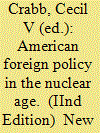

|
|
|
|
|
| Edition |
IInd Edition
|
| Publication |
New York, Harper and Row, Publishers, 1965.
|
| Description |
ix, 500p.
|
|
|
|
|
|
|
|
|
|
|
|
Copies: C:1/I:0,R:0,Q:0
Circulation
| Accession# | Call# | Current Location | Status | Policy | Location |
| 000617 | 327.73/CRA 000617 | Main | On Shelf | General | |
|
|
|
|
| 2 |
ID:
164616
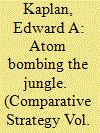

|
|
|
|
|
| Summary/Abstract |
In 1960, the senior Air Force officer in Europe published an article in the Air Force's premier journal in which he advocated using nuclear weapons to combat insurgency. His ideas, as outlandish as they sound to modern ears, were consistent with a belief that a nuclear-armed military designed to flatten a superpower could ably handle lesser contingencies. While most of the theoretical exploration of using America's “best” weapons was in the realm of limited war against major powers, some of that thinking was dedicated to small wars. This article focuses on how the air-atomic USAF envisioned using nuclear weapons in small conflicts against minor powers or insurgencies. The Air Force of the mid- to late-1950s sought solutions to problems using its existing doctrine and equipment. It depended on blunt (nuclear) force delivered by manned aircraft operating independently of ground forces, the USAF struggled with emerging trends in conventional and unconventional warfare, but had confidence it could handle the challenge. As one airpower thinker of the period stated, “The dog we keep to lick the cat can lick the kittens too.”
|
|
|
|
|
|
|
|
|
|
|
|
|
|
|
|
| 3 |
ID:
104330
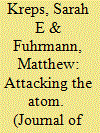

|
|
|
|
|
| Publication |
2011.
|
| Summary/Abstract |
What are the consequences of military strikes against nuclear facilities? In particular, do they 'work' by delaying the target states ability to build the bomb? This article addresses these questions by conducting an analysis of 16 attacks against nuclear facilities from 1942 to 2007. We analyze strikes that occurred during peacetime and raids that took place in the context of an ongoing interstate war. The findings indicate that strikes are neither as uniformly fruitless as the skeptics would suggest, nor as productive as advocates have claimed. There is evidence that the peacetime attacks delayed the target's nuclear program, although the size of this effect is rather modest. The wartime cases were less successful, as attacks often missed their targets either due to operational failure or limited intelligence on the location of critical targets. In our concluding section we show that many of the conditions that were conducive to past success are not present in the contemporary Iran case. Overall, our findings reveal an interesting paradox. The historical cases that have successfully delayed proliferation are those when the attacking state struck well before a nuclear threat was imminent. Yet, this also happens to be when strikes are the least legitimate under international law, meaning that attacking under these conditions is most likely to elicit international censure.
|
|
|
|
|
|
|
|
|
|
|
|
|
|
|
|
| 4 |
ID:
144147
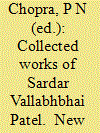

|
|
|
|
|
| Publication |
New Delhi, Konark Publishers Pvt Ltd, 2015.
|
| Description |
xxxiv, 380p.hbk
|
| Contents |
Vol. XIII (1 January 1948 - 31 December 1948): Sardar Patel justifies partition, uniques
role in merging of over 500 princely states in Indian Union, opposes referring
of Kashmir issue to UN, elucidates Gandhiji views on armed intervention in
Kashmir and even making of an Atom bomb, if Necessary.
|
| Standard Number |
9789322008444
|
|
|
|
|
|
|
|
|
|
|
|
Copies: C:1/I:0,R:1,Q:0
Circulation
| Accession# | Call# | Current Location | Status | Policy | Location |
| 058596 | 954.035/CHO 058596 | Main | On Shelf | Reference books | |
|
|
|
|
| 5 |
ID:
144202
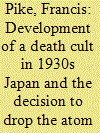

|
|
|
|
|
| Summary/Abstract |
In the 1930s Japan developed a death cult which had a profound effect on the conduct of the Japanese armed forces in the Pacific War, 1941–1945. As a result of government directed propaganda campaign after the overthrow of the Shogunate in 1868, the ruling military cliques restored an Imperial system of government which placed Emperor Meiji as the Godhead central to the constitution and spiritual life of the Japanese nation. A bastardised Bushido cult emerged. It combined with a Social-Darwinist belief in Japan's manifest destiny to dominate Asia. The result was a murderous brutality that became synonymous with Japanese treatment of prisoners of war and conquered civilians. Japan's death cult was equally driven by a belief in self-sacrifice characterised by suicidal Banzai charges and kamikaze attacks. The result was kill ratios of Japanese troops in the Pacific War that were unique in the history of warfare. Even Japanese civilians were expected to sacrifice their lives in equal measure in the defence of the homeland. It was for this reason that American war planners came to the shocking estimate that as many as 900,000 Allied troops could die in the conquest of mainland Japan – Operation DOWNFALL. Contrary to the view of numbers of revisionist historians in the post-war period, who have variously argued that the atom bombs were used to prevent Soviet entry into the war against Japan, Francis Pike, author of Hirohito's War, The Pacific War, 1941 – 1945 [Bloomsbury 2015] reaffirms that the nuclear weapon was used for one purpose alone – to bring the war to a speedy end and to save the lives of American troops.
|
|
|
|
|
|
|
|
|
|
|
|
|
|
|
|
| 6 |
ID:
003078
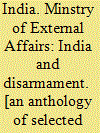

|
|
|
|
|
| Publication |
India, Ministry of External Affairs, 1988.
|
| Description |
294p.
|
|
|
|
|
|
|
|
|
|
|
|
Copies: C:2/I:0,R:0,Q:0
Circulation
| Accession# | Call# | Current Location | Status | Policy | Location |
| 034732 | 327.174/IND 034732 | Main | On Shelf | General | |
| D34732 | 327.174/IND D34732 | Main | On Shelf | General | |
|
|
|
|
| 7 |
ID:
028345
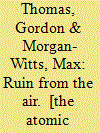

|
|
|
|
|
| Publication |
London, Hamish Hamilton, 1977.
|
| Description |
xvii, 386, ill, bib.Hbk
|
| Standard Number |
241897262
|
|
|
|
|
|
|
|
|
|
|
|
Copies: C:1/I:0,R:0,Q:0
Circulation
| Accession# | Call# | Current Location | Status | Policy | Location |
| 017048 | 940.544252/THO 017048 | Main | On Shelf | General | |
|
|
|
|
|
|
|
|
|